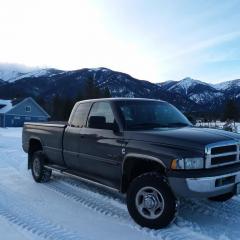- Replies 53
- Views 5.4k
- Created
- Last Reply
Top Posters In This Topic
-
 YeaImDylan 15 posts
YeaImDylan 15 posts -
 Mopar1973Man 7 posts
Mopar1973Man 7 posts -
 dripley 7 posts
dripley 7 posts -
 Silverwolf2691 6 posts
Silverwolf2691 6 posts
Most Popular Posts
-
A couple times on different vehicles I have suspected that the wheel bearing was the issue, but even with it up on the lift I could not "feel" a problem. No movement on the dial indicator nothing.
-
Mike, my unit bearings were both bad and both wheels were still tight! You couldn't tell they were bad. I know this Boss cause I suspected something wasn't right..... kept jacking up the front and al
-
If you compared your Quad speedometer with a GPS unit and they agreed with each other, then I'm thinking you have 4.10 gears - which would be a good match with the tires you have on your truck.




Hello all! So, I'm having suspension issues with the truck and really need them figured out. truck shakes at highway cruising speeds. It will smooth out if I move the wheel slightly (with the slack) and it'll get smoother and not be shaking. It's not death wobble like you see on YouTube but it is definitely annoying and NOT correct lol. I think tires may just need to be balanced and a good alignment. Front driver tire is also a weird wear (mud tires, each tread is up and down alternating, planning to get new wheels soon). Only thing I know that has been done to the truck suspension wise is a leveling kit.
To the next problem, when turning at slow speeds (parking lot speeds) the truck vibrates badly, more so when turning right. Also, when coming to a stop from like 5mph zone down to 0 it'll grind and rattle, even without brake engaged and the shake will be felt in all 3 pedals. I'm thinking wheel bearings? Rotors and all that I believe were replaced by P/O but not sure how good of a job they did due to other work on the truck....
Last thing is presumable powertrain related but I hear a noise right in the bellhousing... Doesn't sound like a deep knock like a beginning rod knock but it sounded the same as a video I found online and the guy said it was his flexplate being loose/cracked. They sounded almost identical but I have a flywheel due to it being a manual. Truck has a South Bend dual disc setup and the noise stays even with clutch pedal pressed. I'm not sure if the P/O replaced the flywheel or if it has 300k on it like the truck has or he did replace it and maybe didn't torque the bolts correctly.
Any and all suggestions is welcome! Whether it is for all 3 problems or just the one!
Edit: Truck supposedly had all 4 ball joints replaced, calipers and rotors, front shocks at 300k, at 319k now.
Thank you
Dylan.
Edited by YeaImDylan